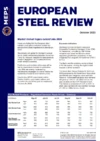Steel producers’ pricing policy squeezes distributors
By the middle of January, several major European steel producers had signalled significant price rises to the market, citing increased input costs. Distributors are sceptical about the longevity of such a move. Consumer demand has yet to pick up and many believe that premature rises will stifle any demand recovery.
The traditionally slow start to the year extended into the second week of the month. The return of southern European mills, after the festive break, did not result in a flurry of activity. Producers were calmly assessing forward orders and calculating the effects of raw material cost increases.
Steelworks’ capacity cuts, introduced late last year, continue to restrict output. Nonetheless, mills sold volumes, in December, to fill first quarter programmes. In addition, coil producers are reserving space for contract customers, who agreed new deals above prevailing spot prices. Consequently, domestic flat product delivery lead times, for spot business, started to extend to March and beyond.
Steel service centres and distributors took advantage of the attractive December discounts to secure volumes for the first quarter of 2023. They reasoned that prices would quickly return to early December levels and then rise further, if modestly. The buying risk was minimal.
The distribution sector is sitting on stocks purchased at higher than current market prices. It would welcome an upward movement to redress this imbalance. The initial expectation, for flat products, was of a €50 per tonne increase, but in gradual stages over the first trimester.
Since the Covid-induced rapid price hikes, however, the mills’ pricing philosophy has altered. Small movements are no longer deemed sufficient. Major producers consider €50 per tonne to be the minimum starting point, regardless of market conditions.
Demand, however, remains fragile, and large hikes threaten new and existing projects. Some end-users still seek further price reductions, in line with late fourth quarter drops, which service centres are resisting. Despite evidence of destocking and shortages of certain products, distributors cannot afford to replenish inventory at prices higher than outsell values.
Many stockists fear a short-term price bubble, with a collapse in April. Those who purchased in good time and who are receiving competitive import volumes, cleared at the start of January, will sit tight on existing orders. If the automotive industry maintains its moderate growth, mills will once again start to seek orders later in the first quarter, with the inevitable downward price correction.

Source:
European Steel Review
The MEPS European Steel Review is an informative, concise and easy-to-use monthly publication, offering unique professional insight into European carbon steel prices.
Go to productRequest a free publication





